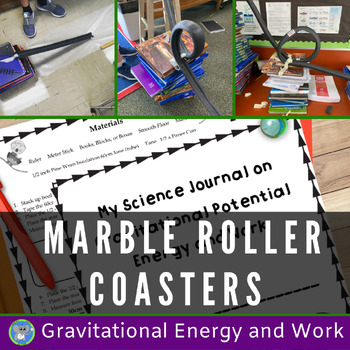Gravity Force And Motion Lesson | Marble Run Roller Coaster Science And STEM
- Zip
What educators are saying
Description
Creating marble roller coasters is a fantastic and budget-friendly STEM activity. Many teachers use this as an End of the Year Activity. The teacher guide and student activity pages make it easy to implement. Learning about gravitational potential energy has never been more fun and memorable.
Included in the Hands-On Science and STEM Unit:
- Video Explanation
- Next Generation Science Standards Correlation
- Teacher Background Information and Tips (including vocabulary and Laws of Energy)
- Activity 1 Science Journal following the scientific method.
- Choice of two data tables. Depending on ability, students can do 1 or 3 trials. Both pages are included.
- Roller Coaster STEM Design Challenge Description
- Roller Coaster STEM Design Challenge Student Pages
- Answer Keys
In this unit, students will explore the concepts of forces and interactions through the scientific method, focusing on gravitational potential energy. Through hands-on learning, they will investigate terms such as energy, work, kinetic energy, gravity, and gravitational potential energy. They will apply the engineering design process to build a roller coaster that meets certain criteria. This involves defining the problem, testing, redesigning, and sharing their roller coaster-building process. By taking charge of their learning, students will be fully engaged and will create a truly memorable experience.
By the end of the activities, students can answer the question:
Does the height of a marble affect the distance a cup will travel?
Teachers will delight in students discovering vocabulary instead of just memorizing it. Materials are affordable and reusable for multiple years. Customizable with differentiated pages for one or three trials. Comprehensive background information and tips improve success. Students will want to construct all day, and teachers will want more time, too.
Supplies needed
½ inch pipe wrap insulation (available at hardware stores and inexpensive)
masking tape, paper cups, rulers, tape measure, books or blocks, paper, marbles, scissors, and other items that may help hold the coaster together. The tubing can be utilized for several years.
Great for the classroom, classroom STEM Fair projects, science clubs, scout groups, homeschoolers, and anyone wanting to learn about forces and motion.
You might also like
- Inertia Exploration Task Cards: Discover the 1st Law of Motion
- Inertia and Gravity Lab: Investigate the Laws of Motion with 4th and 5th Grade
- Valentine Candy Heart Science: K-5th Grade Bundle On Sinking And Floating
Remember, leaving feedback earns you points toward FREE TPT purchases. We love hearing how the investigation went.
Also, follow us and be notified when new explorations are uploaded and deals.
Please contact us with any questions. We are here to help.
Yours in Science,
Kimberly Scott
All parts are copyrighted. Please see the terms of use in the download. Please use good lab practices. The seller is not responsible for the use or misuse of the activities.





